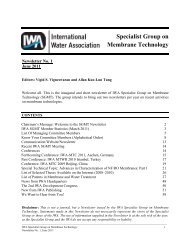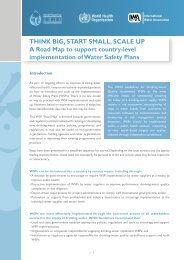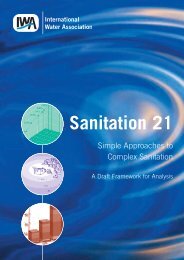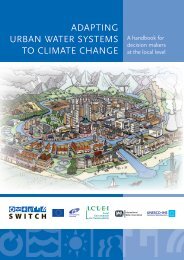Specialist Group on ANAEROBIC DIGESTION Newsletter - IWA
Specialist Group on ANAEROBIC DIGESTION Newsletter - IWA
Specialist Group on ANAEROBIC DIGESTION Newsletter - IWA
Create successful ePaper yourself
Turn your PDF publications into a flip-book with our unique Google optimized e-Paper software.
Anaerobic digesti<strong>on</strong> in sustainable biomass chains<br />
Instituti<strong>on</strong>:<br />
Sub-department of Envir<strong>on</strong>mental Technology<br />
Wageningen University<br />
Wageningen, The Netherlands<br />
Supervisors:<br />
Jules van Lier<br />
Rudy Rabbinge<br />
by Claudia P. Pab<strong>on</strong> Pereira<br />
Abstract:<br />
This thesis evaluates the potential c<strong>on</strong>tributi<strong>on</strong> of anaerobic digesti<strong>on</strong> (AD) to the sustainability of biomass<br />
chains. Results provide insights in the technological potential to recover energy and valuable by-products from<br />
energy crops and residues, and evaluate biomass cascades involving AD technology for their feasibility and<br />
desirability. Embedding AD in biomass chains addresses current c<strong>on</strong>straints towards increased use of biomass<br />
for energy producti<strong>on</strong> c<strong>on</strong>sidering land competiti<strong>on</strong> and envir<strong>on</strong>mental polluti<strong>on</strong>. Within this panorama so far<br />
major advantages of AD to improve energy efficiency and closing material cycles have received a limited<br />
attenti<strong>on</strong>. As part of the experimental research an Oxitop® protocol was refined for screening plant material<br />
suitable for anaerobic digesti<strong>on</strong> based <strong>on</strong> their energy c<strong>on</strong>tent. Envir<strong>on</strong>mental factors influencing the test<br />
outcome are the use of NaOH pellets for CO 2 scavenging, substrate pretreatment, microbial culture, and type of<br />
buffer. The use of NaOH pellets and substarte pretreatments were most influential <strong>on</strong> the results. By means of<br />
the developed Oxitop® protocol the relati<strong>on</strong>ship between plant ligno-cellulosic compositi<strong>on</strong> and the biomethane<br />
potential (BMP) and hydrolysis rates was researched. The Acid Detergent Fibre (ADF) and the Neutral<br />
Detergent Fibre (NDF) as analyzed by the van Soest method were proposed as suitable plant characterizati<strong>on</strong><br />
techniques for predicting the biodegradability and hydrolysis c<strong>on</strong>stants. The biodegradability model developed<br />
was further used to predict the biodegradability of 114 European plant samples identifying interesting crops and<br />
crop residues suitable for anaerobic digesti<strong>on</strong>. Batch experiments <strong>on</strong> digestate quality showed an increase of 20-<br />
26% and 0-36% in solublised NH 4 + and PO 4 3- , respectively, after 2 m<strong>on</strong>ths of digesti<strong>on</strong>. The largest fracti<strong>on</strong>s of<br />
the inorganic nutrients were found in the liquid fracti<strong>on</strong> of the digestate, i.e. 80-92% NH 4 + and 65-74% PO 4 3- .<br />
Increase in manure c<strong>on</strong>tent in the mixture showed a positive effect in the methane producti<strong>on</strong> rate and the total<br />
amount of nutrients in the digestate.<br />
The added value of AD within different biomass cascades was evaluated using the sustainable development<br />
c<strong>on</strong>cept in a specified system boundary. The sensitivity analysis of the energy balance of an AD facility shows<br />
that heat losses become the most important energy loss when high value substrate such as energy maize are<br />
employed. In c<strong>on</strong>trast, when a low energy substrate such as manure is used, the indirect energy of the<br />
infrastructure facilities, become the most important energy input. A sustainability framework was proposed for<br />
evaluating the potential role of AD in biomass cascades applied for the Colombian situati<strong>on</strong>. Results show that<br />
producti<strong>on</strong> of bio-ethanol from cassava is <strong>on</strong>ly sustainable from an energy and greenhouse gas (GHG)<br />
perspective when energy recovery from the process residues, using AD, is part of the process. The exact<br />
outcome of the evaluati<strong>on</strong> largely depends <strong>on</strong> variables like substrate drying, type of fuel used and type of<br />
applied AD system. During the study of other biomass cascades the c<strong>on</strong>tributi<strong>on</strong> of by-products was shown to be<br />
crucial, c<strong>on</strong>stituting 41-68% of the sum of all energy flows. For oil palm, sugarcane, panelacane and cassava,<br />
the energy c<strong>on</strong>tributi<strong>on</strong> of the byproducts to the different biofuel systems fluctuates between 51-158, 122-290,<br />
71-170, and 36-71 GJ.ha -1 yr -1 , respectively. AD had also a positive impact <strong>on</strong> nutrient recovery and water<br />
savings in the studied chains. The energy, nutrient and water benefits were set in perspective by giving an<br />
indicati<strong>on</strong> <strong>on</strong> the ec<strong>on</strong>omic benefits and land savings potentially attainable under Colombian c<strong>on</strong>diti<strong>on</strong>s.<br />
<strong>IWA</strong> <str<strong>on</strong>g>Specialist</str<strong>on</strong>g> <str<strong>on</strong>g>Group</str<strong>on</strong>g> <strong>on</strong> Anaerobic Digesti<strong>on</strong><br />
24 June 2009 <strong>Newsletter</strong>

















